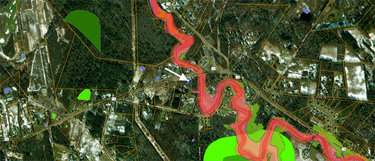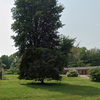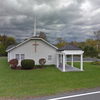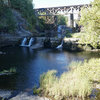New DEC wetland regs postpone review of contractor yard
— From town of Guilderland Interactive Mapping
A proposal for contractor storage space at 643 Route 146 was tabled while the state’s Department of Environmental Conservation determines if it has jurisdictional authority over wetlands on the site. The red on the map indicates a 100-foot buffer around a watercourse, while the green indicates a FEMA flood zone.
GUILDERLAND — New state regulations related to freshwater wetlands are starting to be felt locally.
Starting Jan. 1, rules went into effect that significantly expanded New York state’s jurisdiction over freshwater wetlands with the aim of protecting a million additional acres of wetland habitats.
The new regulations came up during a site plan review the Guilderland Planning Board undertook during its Feb. 12 meeting.
Project applicant Floccuzio Construction is looking to build 42,500 square feet of commercial building space on 7.3 acres of land located at 643 Route 146, across the road from Staucet’s Nursery
The square footage, which would be leased only to contractors, would be spread across four buildings: an 8,000-square-foot structure, 80 feet by 100 feet; a 12,000-square-foot building, 150 feet by 80 feet; another 12,000-square-foot building, 210 feet by 57 feet; and a third 12,000-square-foot building, 240 feet by 50 feet.
During the meeting, Town Planner Kenneth Kovalchik explained that the town’s zoning board of appeals is the lead agency for the application and that the role of the planning board is to review the site plan and provide recommendations to the zoning board for it to consider as part of the special-use permitting process.
“I think the biggest issue that the board is going to have to consider tonight is related to the new DEC freshwater wetland regulations,” Kovalchik said. “They became effective on January 1st.”
The property contains existing federal wetlands, Kovalchik said.
“Based on the new regulations,” Kovalchik said. “DEC could claim jurisdiction to those federal wetlands, and they would become state freshwater wetlands, which are more restrictive to build.”
Kovalchik said there are now 11 criteria that the DEC looks at related to wetlands to determine whether it will take jurisdiction over land.
As it relates to Floccuzio, Kovalchik said, “The applicant did reach out to DEC,” and that the agency “responded claiming that [Floccuzio] has to submit a jurisdictional determination request, which tells me that, in my opinion, the planning board can start the site-plan review.”
Kovalchik concluded, “But until we know if the wetlands that have been delineated on the property are going to remain federal or become state freshwater wetlands, which could significantly change the layout, we should proceed with caution.”
New regs
Wetlands offer significant ecological and human benefits, including stormwater control; sediment and pollutant retention; carbon sequestration; groundwater recharge and discharge; water quality improvements; fish and wildlife habitats; complex food chains; and spaces for recreation, open space, research, and education.
Wetlands act like sponges, slowing down and absorbing water that could otherwise cause catastrophic floods, which is later released during drier spells, thereby protecting against both flooding and drought; wetlands can store immense amounts of water, up to one million gallons per acre.
It’s estimated that New York State has lost over 60 percent of its wetlands due to human development, but with the new regulations will add a million more acres of wetlands.
New York state in 1975 enacted the Freshwater Wetlands Act, granting the DEC the authority to regulate freshwater wetlands. Under these rules, the DEC oversees wetlands that measure at least 12.4 acres, as well as smaller wetlands determined to have “unusual local importance,” plus a surrounding 100-foot buffer area.
The original wetlands maps called for in the Freshwater Wetlands Act are quite limited: They were hand-drawn and did not show the actual limits of most of the state-protected wetlands, meaning hundreds of thousands of acres of wetlands in high development areas of New York that were not on official maps.
But a 2022 expansion of the Freshwater Wetlands Act allows the state to regulate wetlands of “Unusual Importance” regardless of size (based on the 11 criteria referred to by Kovalchik) and will expand the DEC’s reach by shrinking the acreage that comes under its jurisdiction, from 12.4 acres to 7.4 acres by 2028.
If the DEC determines that a wetland meets one of the 11 criteria, it can claim jurisdiction over the land, negating any attempts to develop it. According to the DEC, “Wetlands of any size meet jurisdictional criteria for protection if they possess any of the following characteristics:
— “Located within a watershed experiencing significant flooding;
— “Situated within or adjacent to an urban area, as defined by the US Census Bureau;
— “Contains rare or endangered plant species;
— “Provides critical habitat for essential behaviors of endangered, threatened, or special concern species, or species of greatest conservation need (SGCN);
— “Classified as a Class I wetland, indicating the highest ecological value;
— “Previously mapped and classified as a wetland of unusual local importance;
— “Identified as a vernal pool that supports productive amphibian breeding;
— “Located within a FEMA [Federal Emergency Management Agency]-designated floodway, highlighting its importance in flood mitigation;
— “Previously mapped by the department on or before December 31, 2024;
— “Holds local or regional ecological significance; or
— “Plays a significant role in protecting the state’s water quality.”
The proposal
The 7.3-acre parcel being reviewed by the planning board is part of a five-lot subdivision Floccuzio obtained in July 2021. The final plat plan showed four single-family lots being built-out and being accessible only from Weaver Road, with the 7.3-acre Lot 5 along Route 146 remaining undeveloped at the time.
Mike Flocuzzio, the applicant, said during a June 2021 meeting that his original subdivision proposal included duplexes on Lot 5 — the initial plan was to subdivide Lot 5 in two and place a two-family home on each parcel, but the board placed a subdivision restriction on Lot 5 at a subsequent meeting.
With Flocuzzio amending an earlier plat proposal that included a keyhole lot, the board at that July 2021 meeting voted to remove the restriction placed on Lot 5, allowing Flocuzzio to further subdivide the seven-acre parcel.
Project engineer Pete Yetto with Ingalls & Associates told board members on Feb. 12 that the two 200-plus-foot long buildings would each be divided into six 2,000-square-foot units while the other 12,000-square-foot space would be divided in half as would the 8,000-square-foot building.
“This is set up for people to lease,” Yetto said. “It could be a plumber; it could be an electrician. It’s more of a location you can work out of,” he said, adding, “I guess you could look at it similar to a layout of storage units, but it’s not necessarily storage units; you’ll have mainly garage doors along the front.”
There were repeated references to the proposal as a self-storage facility, which Yetto sought to make clear wasn’t the case. “They’re not a storage facility. They’re heated, they’ll have a bathroom … They’re not designed for workplaces of people staying there working,” said Yetto, explaining that contractors won’t run businesses out of his buildings; rather, they will keep their equipment and supplies there.
Chairman Stephen Feeney said he would look for clarification from the town’s building and zoning inspector Jaqueline Coons “as to what’s self-storage versus a contractor yard,” because “the two long buildings look like self-storage to me.”
The board then decided to table the proposal until the DEC made a jurisdictional determination about the wetlands on-site — which it has 90 days to do, per the new regulations.



